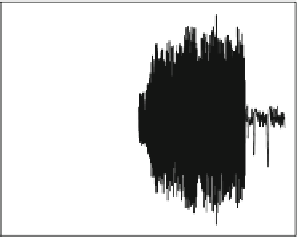Biomedical Engineering Reference
In-Depth Information
a
b
600
400
1
200
0
0
−200
−400
−1
−600
0
100
200
300
400
500
600
700
800
0
100
200
300
400
500
600
700
800
T−wave index, i
T−wave index, i
Fig. 3.7
TWA detection during angioplasty. (
a
) First component of vector
θ
i
in model (
3.12
)
estimated by the PCA-based method of Sect.
3.2.3
. The alternans of the parameter appears in the
range
300
≤ i ≤
650
.(
b
) Welch's
t
test output for
p<
0
.
01
from the PCA results displayed in (
a
).
Changes in alternans phase
(0
,
1
, −
1)
are clearly visible
in [
16
] by considering the matrix made up of the
N
available T-wave realizations:
X
=[
x
1
,
x
2
,...,
x
N
]
∈R
L×N
. The rank-
k
subspace best describing in the least
square sense the observation space, i.e., the subspace spanned by the columns of
X
,
is spanned by the columns of any given rank-
matrix
A
and the
(
k−
)
dominant left
singular vectors of matrix
I
−
A
(
A
T
X
. Fixing
k
=3
and
A
=
1I
,this
result yields the sample version of the above derivations. To enhance the varying
nature of the TWA phenomenon, the data can be transformed according to the
derivative operator
δ
x
i
=(
x
i
−
x
i−
1
)
before applying the detection method.
The PCA-based approach described in this section is valid for any extended
model of observation disturbances. For instance, a detrending step can also be
applied as in [
17
], where a more refined model accounting for an affine baseline
wandering has also been proposed in the context of noninvasive atrial activity
extraction during AF using a similar framework.
T
A
)
−
1
A
3.2.4
Success Story: T-Wave Alternans Detection During
Angioplasty
The TWA detection approach described in the previous section has been applied
to real data acquired during angioplasty (STAFF III database) [
15
]. Angioplasty
consists in the inflation of a balloon in the coronary artery to treat arterial stenosis.
This procedure temporarily provokes ischemia and induces changes in cardiac cell
properties that may cause TWA. Figure
3.7
a displays the first entry of vector
θ
i
in
model (
3.12
) (or of vector
˜
θ
i
in Eqs. (
3.14
)and(
3.15
)) when using
δ
x
i
from the
T-wave dataset.













































































Search WWH ::

Custom Search